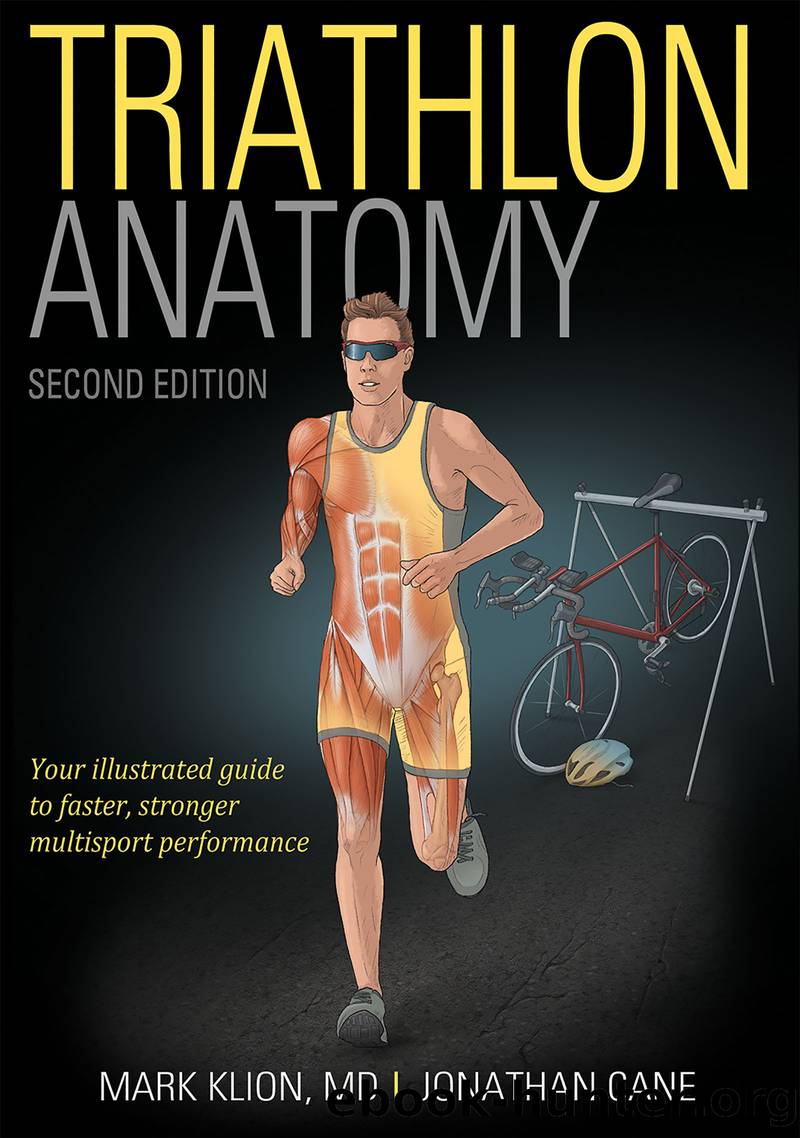Triathlon Anatomy by Mark Klion

Author:Mark Klion
Language: eng
Format: epub
Publisher: Human Kinetics, Inc.
FIGURE 6.1 Muscles of the chest.
The pectoralis minor, which is a smaller muscle, lies beneath the pectoralis major. It takes its origin from the anterior upper ribs and inserts into the medial border of the scapula and a bony projection from the scapula called the coracoid process. Its function is to help control the scapula, stabilizing it against the thoracic wall during arm elevation.
The serratus anterior, known as the boxer’s muscle, is a deep muscle group that originates from the upper ribs on each side of the chest and inserts along the entire length of the medial scapula. Its function, stabilization of the scapula, is similar to that of the pectoralis minor. It helps pull the scapula forward during the recovery and initial catch phases of swimming. During breathing, the serratus anterior also assists in chest expansion.
EXERCISES FOR THE CHEST
Common strength training exercises that many athletes learn early in their careers, including the bench press, military press, and dip, preferentially strengthen the front of the shoulder and chest. If these exercises are done exclusively, this can create a muscle imbalance that causes the shoulders to roll forward, and subsequently it may cause stiffness in the front of the shoulders. In swimming, this contracted position may cause the rotator cuff to overwork, leading to a spectrum of injuries, including shoulder impingement. Symptoms commonly include shoulder pain and limited motion. In cycling, weak chest and upper-extremity muscles plus a rounded shoulder position put the neck and upper back at risk for a soft-tissue injury, called a strain. Symptoms of this type of strain may manifest as difficulty staying in the aerobars and even difficulty keeping the head up when riding for extended periods. In running, a rounded shoulder position can cause a constriction of the chest wall, limiting chest expansion and proper breathing, and an abnormal arm motion, such as swinging across the body, which can decrease running efficiency.
The following exercises, which include the simple (but challenging) push-up and dip, need to be balanced with exercises that target scapular rotators, fine-tune coordinators, and the power muscles of the back. Increased emphasis on the less sexy, showy muscles, including those of the back and rotator cuff, will pay large dividends in injury prevention. A simple ratio of two-to-one back-to-chest strength training will help keep you healthy.
For the triathlete, the power-to-weight ratio is a key factor in performance, especially in cycling and running, since gravity and wind resistance play a key role in affecting speed. Therefore, building muscular strength and endurance without packing on additional weight is a goal. For most of the exercises in this chapter, perform two or three sets of 10 to 15 repetitions with strict form. Select weights that enable you to finish the required number of repetitions but with considerable effort for the last few repetitions. As you become more experienced in strength training, you may choose to perform one set to exhaustion, a point at which another repetition would be nearly impossible without assistance from a spotter or compromises to form and safety.
Download
This site does not store any files on its server. We only index and link to content provided by other sites. Please contact the content providers to delete copyright contents if any and email us, we'll remove relevant links or contents immediately.
Tools of Titans by Timothy Ferriss(7815)
Bodyweight Strength Training by Jay Cardiello(7676)
Born to Run: by Christopher McDougall(6895)
Inner Engineering: A Yogi's Guide to Joy by Sadhguru(6441)
Asking the Right Questions: A Guide to Critical Thinking by M. Neil Browne & Stuart M. Keeley(5357)
The Fat Loss Plan by Joe Wicks(4622)
Bodyweight Strength Training Anatomy by Bret Contreras(4472)
Yoga Anatomy by Kaminoff Leslie(4103)
Science and Development of Muscle Hypertrophy by Brad Schoenfeld(3971)
Dynamic Alignment Through Imagery by Eric Franklin(3920)
ACSM's Complete Guide to Fitness & Health by ACSM(3824)
The Four-Pack Revolution by Chael Sonnen & Ryan Parsons(3795)
Exercise Technique Manual for Resistance Training by National Strength & Conditioning Association(3788)
Bodyweight Strength Training: 12 Weeks to Build Muscle and Burn Fat by Jay Cardiello(3781)
Yoga Anatomy by Leslie Kaminoff & Amy Matthews(3740)
The Ultimate Bodybuilding Cookbook by Kendall Lou Schmidt(3708)
Yoga Therapy by Mark Stephens(3574)
Nutrition for Sport, Exercise, and Health by Spano Marie & Kruskall Laura & Thomas D. Travis(3556)
Nutrition for Sport, Exercise, and Health by Marie Spano & Laura Kruskall & D. Travis Thomas(3548)
